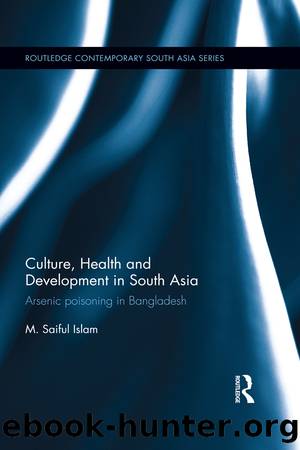Culture, Health and Development in South Asia by M. Saiful Islam

Author:M. Saiful Islam [Islam, M. Saiful]
Language: eng
Format: epub
ISBN: 9780367877712
Barnesnoble:
Publisher: Taylor & Francis
Published: 2019-12-12T00:00:00+00:00
Barir chikitsa: the home-based remedy of ghaa
The initial treatment of ghaa usually starts at home with self-treatment using either home remedies or herbal medicines that are known to be effective in treating specific diseases based on indigenous pharmacology. The concepts of self-treatment or home-based treatment, however, appeared problematic to me, since I did not find exact terminology in the local language that denoted these terms. Jackson and Jackson-Carroll (1994) encountered the same situation when exploring routine health behaviour among the Tamang people of Nepal, who do not consider home treatment to be a significant healing option. Jackson and Jackson-Carroll (1994: 1008) note:
If asked, âWhat do you do at home if your son or daughter has cherba?â People uniformly responded, âWe donât do anything, we donât know what to do, only the bombo knows what to do, we go to the bombo.â
I faced similar difficulty when exploring the routine management of ghaa at home. A question like âwhat do you do when ghaa appears?â simply yielded answers like âwe do not do anything⦠we go to the doctorâ or resulted in a description of treatment processes received outside the home. The standard local word that is commonly used to refer to treatment is chikitsa, which literally means treatment received outside the home or provided by healers or doctors. Although my interest was to explore the rudimentary home-based treatment of ghaa, villagers frequently referred to chikitsa or the treatment processes that are received outside the home. Later I came across the term barir chikitsa, which literally means home treatment that local villagers use to refer to the practices and activities associated with the treatment at the household level.
As has been demonstrated previously, ghaa, a general skin disease, is very common in rural Bangladesh. Often patients do not recognize the onset of such ghaa unless it takes a severe form and limits their ability to engage in physical activities. Most patients informed me that they did not do anything when they first noticed small blisters or ghaa on their body. It only becomes a matter of concern for them when they first notice a discharge from the ghaa. Barir chikitsa generally starts with an adjustment in dietary intake and the use of common remedies that are available at home. Since recurrence is one common feature of ghaa, many patients informed me that they do not take any extra care when ghaa remains in a dormant stage. However, there are particular seasons when ghaa reappears and sometimes takes a severe form. Cleaning discharge from ghaa would then become a routine activity for patients and their family members. It was usually the mother or other female members of the family who help in cleaning the ghaa. Small pieces of cloth were used to clean the affected areas. Some patients used liquid dettol as an antiseptic for cleaning purposes, while many others, who could not afford dettol or were unaware of the use of antiseptics, used only boiled water. Many patients also used boiled water with
Download
This site does not store any files on its server. We only index and link to content provided by other sites. Please contact the content providers to delete copyright contents if any and email us, we'll remove relevant links or contents immediately.
Application of a Novel Technique for Clinical Evaluation of Nitric Oxide-Induced Free Radical Reactions in ICU Patients by Unknown(696)
Rosenâs Emergency Medicine Concepts and Clinical Practice by Ron Walls; Robert Hockberger; Marianne Gausche-Hill; Timothy B. Erickson; Susan R. Wilcox(574)
Oxidative damage to surfactant protein D in pulmonary diseases by Vitality Starosta1 & Matthias Griese1†(410)
Social Science Perspectives on Global Public Health by Vincent La Placa & Julia Morgan(375)
Constructing Canine Consent; Conceptualising and Adopting a Consent-focused Relationship with Dogs by ERIN JONES(330)
Organic Chemistry: An Acid - Base Approach by MICHAEL SMITH(304)
ADVANCED EMERGENCY CARE AND TRANSPORTATION OF THE SICK AND INJURED by Unknown(272)
Saunders Nursing Drug Handbook 2024 - E-Book by Unknown(264)
Davis's Comprehensive Manual of Laboratory and Diagnostic Tests with Nursing Implications by Unknown(250)
Socio-Life Science and the COVID-19 Outbreak : Public Health and Public Policy by Makoto Yano; Fumihiko Matsuda; Anavaj Sakuntabhai; Shigeru Hirota(247)
Diagnostic and Statistical Manual of Mental Disorders, Fifth Edition, Text Revision (DSM-5-TR(tm)) by Unknown(246)
Human Microanatomy; Cell Tissue and Organ Histology with Celebrity Medical Histories by Stephen A. Stricker(245)
Berne and Levy Physiology E-Book by Unknown(237)
Replacing the Dead by Mie Nakachi;(232)
Handbook of Skin Disease Management by Jiyad Zainab;Flohr Carsten; & Carsten Flohr(229)
Access to Medicines and Vaccines in the South : Coherence of Rules and Policies Applied by the European Union Commission by Stephen Kingah(227)
Deep Learning and Medical Applications by Unknown(222)
The Pocket Guide to Sensorimotor Psychotherapy in Context (Norton Series on Interpersonal Neurobiology) by Pat Ogden(219)
Advances and Technical Standards in Neurosurgery by Unknown(215)
